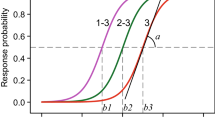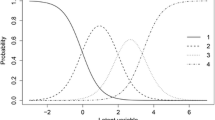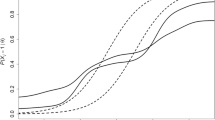Abstract
In health studies, questionnaire items are often scored on an ordinal scale, for example on a Likert scale. For such questionnaires, item response theory (IRT) models provide a useful approach for obtaining summary scores for subjects (i.e., the model’s random subject effect) and characteristics of the items (e.g., item difficulty and discrimination). In this article, we describe a model that allows the items to additionally exhibit different within-subject variance, and also includes a subject-level random effect to the within-subject variance specification. This permits subjects to be characterized in terms of their mean level, or location, and their variability, or scale, and the model allows item difficulty and discrimination in terms of both random subject effects (location and scale). We illustrate application of this location-scale mixed model using data from the Social Subscale of the Drinking Motives Questionnaire assessed in an adolescent study. We show that the proposed model fits the data significantly better than simpler IRT models, and is able to identify items and subjects that are not well-fit by the simpler models. The proposed model has useful applications in many areas where questionnaires are often rated on an ordinal scale, and there is interest in characterizing subjects in terms of both their mean and variability.
Similar content being viewed by others
References
Agresti, A., Lang, J.B.: A proportional odds model with subject-specific effects for repeated ordered categorical responses. Biometrika 80, 527–534 (1993)
Aitkin, M.: Modelling variance heterogeneity in normal regression using GLIM. Appl. Stat. 36, 332–339 (1987)
Bock, R.D., Aitken, M.: Marginal maximum likelihood estimation of item parameters: application of an EM algorithm. Psychometrika 46, 443–459 (1981)
Cooper, M.L.: Motivations for alcohol use among adolescents: development and validation of a four-factor model. Psychol. Assess. 6, 117–128 (1994)
Cox, C.: Location-scale cumulative odds models for ordinal data: a generalized non-linear model approach. Stat. Med. 14, 1191–1203 (1995)
Dierker, L., Mermelstein, R.: Early emerging nicotine-dependence symptoms: a signal of propensity for chronic smoking behavior in adolescents. J. Pediatr. 156, 818–822 (2010)
Dorman, J.: The effect of clustering on statistical tests: an illustration using classroom environment data. Educ. Psychol. 28, 583–595 (2008)
Ezzet, F., Whitehead, J.: A random effects model for ordinal responses from a crossover trial. Stat. Med. 10, 901–907 (1991)
Harvey, A.C.: Estimating regression models with multiplicative heteroscedasticity. Econometrica 44, 461–465 (1976)
Hedeker, D., Berbaum, M., Mermelstein, R.: Location-scale models for multilevel ordinal data: between- and within-subjects variance modeling. J. Probab. Stat. Sci. 4, 1–20 (2006)
Hedeker, D., Demirtas, H., Mermelstein, R.J.: A mixed ordinal location-scale model for analysis of ecological momentary assessment data. Stat. Interface 2, 391–402 (2009)
Hedeker, D., Gibbons, R.D.: A random-effects ordinal regression model for multilevel analysis. Biometrics 50, 933–944 (1994)
Hedeker, D., Gibbons, R.D.: Longitudinal Data Analysis Longitudinal Data Analysis. Wiley, New York (2006)
Hedeker, D., Mermelstein, R.J.: A multilevel thresholds of change model for analysis of stages of change data. Multivar. Behav. Res. 33, 427–455 (1998)
Hedeker, D., Mermelstein, R.J., Flay, B.R.: Models for intensive longitudinal data. In: Walls, T.A., Schafer, J.L. (eds.) Application of Item Response Theory Models for Intensive Longitudinal Data, pp. 84–108. Oxford University Press, New York (2006)
Ishwaran, H., Gatsonis, C.: A general class of hierarchical ordinal regression models with applications to correlated ROC analysis. Can. J. Stat. 28, 731–750 (2000)
Johnson, T.R.: On the use of heterogeneous thresholds ordinal regression models to account for individual differences in response style. Psychometrika 68, 563–583 (2003)
Leckie, G., French, R., Charlton, C., Browne, W.: Modeling heterogeneous variance-covariance components in two-level models. J. Educ. Behav. Stat. 39, 307–332 (2014)
McCullagh, P.: Regression models for ordinal data (with discussion). J. R. Stat. Soc. Ser. B 42, 109–142 (1980)
McCullagh, P., Nelder, J.A.: Generalized Linear Models, 2nd edn. Chapman and Hall, New York (1989)
Rijmen, F., Tuerlinckx, F., De Boeck, P., Kuppens, P.: A nonlinear mixed model framework for item response theory. Psychol. Methods 8, 185–205 (2003)
Saei, A., McGilchrist, C.A.: Longitudinal threshold models with random components. J. R. Stat. Soc. Ser. D (Stat.) 47, 365–375 (1998)
Samejima, F.: Estimation of latent ability using a response pattern of graded scores. Psychom. Monogr. 17, 1–100 (1969)
Shiffman, S., Waters, A., Hickcox, M.: The nicotine dependence syndrome scale: a multidimensional measure of nicotine dependence. Nicotine Tob. Res. 6, 327–348 (2004)
Skrondal, A., Rabe-Hesketh, S.: Generalized Latent Variable Modeling: Multilevel, Longitudinal, and Structural Equation Models. Chapman and Hall/CRC, New York (2004)
Toledano, A.Y., Gatsonis, C.: Ordinal regression methodology for ROC curves derived from correlated data. Stat. Med. 15, 1807–1826 (1996)
Tosteson, A.N., Begg, C.B.: A general regression methodology for ROC curve estimation. Med. Decis. Mak. 8, 204–215 (1988)
Tutz, G., Hennevogl, W.: Random effects in ordinal regression models. Comput. Stat. Data Anal. 22, 537–557 (1996)
Funding
This study was funded by National Cancer Institute grant P01 CA98262 (Mermelstein, PI) and National Heart Lung and Blood Institute grant R01 HL121330 (Hedeker & Dunton).
Author information
Authors and Affiliations
Corresponding author
Ethics declarations
Conflict of interest
All authors declare that he/she has no conflict of interest.
Ethical approval
All procedures performed in studies involving human participants were in accordance with the ethical standards of the institutional and/or national research committee and with the 1964 Helsinki declaration and its later amendments or comparable ethical standards.
Informed consent
Informed consent was obtained from all individual participants included in the study.
Additional information
Supported by National Cancer Institute grant P01 CA98262 (Mermelstein, PI) and National Heart Lung and Blood Institute grant R01 HL121330 (Hedeker & Dunton). Thanks to Oksana Pugach for aiding in carrying out the simulation studies.
Appendix: SAS PROC NLMIXED syntax
Appendix: SAS PROC NLMIXED syntax
Below is a sample of syntax necessary to run the mixed-effects ordinal location-scale model described in this article. Uppercase letters are used for SAS specific syntax and lowercase letters are used for user defined entities. In terms of the variables used in this syntax, id is a subject identifier, y denotes the ordinal outcome and x1 to x3 are item indicators. Here, for simplicity, we illustrate the syntax consdering only three items and three response categories. The two cumulative logits are clogit1 and clogit2, and the two cumulative probabilities are cprob1 and cprob2. The random location effect is named theta, the random scale effect is zeta, and their correlation is corr. The location model is summarized by loc, while the scale model is given by scale.

Users must provide starting values for all parameters on the PARMS statement. To do so, it is beneficial to run the model in stages using estimates from a prior stage as starting values and setting the additional parameters to zero or some small value. For example, one can start by estimating a random-intercepts ordinal model with item difficulty (beta1-beta3), item discrimination (delta1-delta3), and threshold parameter (alpha2). Estimates of these parameters can then be specified as starting values in a model that adds in the WS variance parameters (gamma1-gamma3). Finally, the full model with the additional parameters (tau1-tau3 and cor) can be estimated. In practice, this approach works well with PROC NLMIXED, which sometimes has difficulties in converging to a solution for complex models. Furthermore, for complex models, it is sometimes the case that the default convergence criteria is not strict enough. In the above syntax, the convergence criteria is specified as GCONV=1e-12 on the PROC NLMIXED statement.
DMQ social subscale items: category response proportions. Items: (1) as a way to celebrate; (2) because it is what most of my friends do when we get together; (3) to be sociable; (4) because it is customary on special occasions; (5) because it makes a social gathering more enjoyable. Categories: \(\textit{1}=\hbox {almost}\) never, \(\textit{2}=\hbox {some}\) of the time, \(\textit{3}=\hbox {half}\) of the time, \(\textit{4}=\hbox {most}\) of the time, \(\textit{5}=\hbox {almost}\) always
Rights and permissions
About this article
Cite this article
Hedeker, D., Mermelstein, R.J., Demirtas, H. et al. A mixed-effects location-scale model for ordinal questionnaire data. Health Serv Outcomes Res Method 16, 117–131 (2016). https://doi.org/10.1007/s10742-016-0145-9
Received:
Revised:
Accepted:
Published:
Issue Date:
DOI: https://doi.org/10.1007/s10742-016-0145-9





